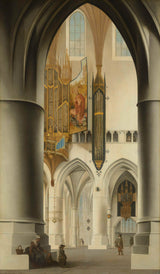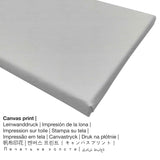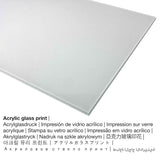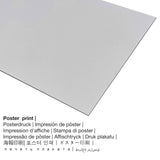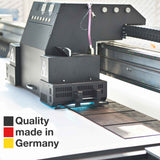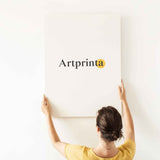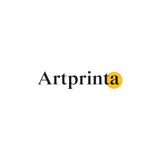Pieter Jansz Saenredam, 1636 - Ime ụlọ ụka St Bavo na Haarlem - ọmarịcha nka.
Ụtụ gụnyere. Mbupu gbakọrọ na ndenye ọpụpụ.
Kedu ihe ị na-amasị?
Ngwa ndetu ngwaahịa na-enye gị ohere ịhọrọ ngwa na nha nke gị. Anyị na-ahapụ gị ka ịhọrọ n'ime ụdị ndị a:
- Mbipụta kanvas: The printed canvas material mounted on a wood frame. How do I hang a canvas on the wall? The great advantage of canvas prints is that they are relatively low in weight. That means, it is quite simple to hang up the Canvas print without the support of additional wall-mounts. Therefore, canvas prints are suited for any kind of wall in your home.
- Mbipụta enyo acrylic: The print on acrylic glass, which is sometimes named as a UV print on plexiglass, will change an original artwork into lovely décor. The artwork is being printed with the help of state-of-the-art UV print technology.
- Mbipụta nke aluminom: An Aluminium Dibond print is a print material with an impressive depth effect, which creates a modern look by having a non-reflective surface structure. The Aluminium Dibond Print is the best introduction to the sophisticated world of fine art replicas on aluminum. For the Aluminium Dibond print, we print your favorite work of art onto the aluminium composite surface. The white and bright parts of the original artpiece shine with a silk gloss, however without glow. This direct UV print on aluminium is the most popular entry-level product and is an extremely sophisticated way to showcase art prints, since it draws focus on the artwork.
- Mbipụta akwụkwọ mmado (ihe kwaaji): Our poster is a UV printed flat canvas paper with a slight surface structure. It is suited for framing your art replica with a special frame. Please note, that depending on the size of the poster we add a white margin 2-6cm around the print to facilitate the framing.
Nkwupụta iwu: We strive in order to depict our art products as exact as we can and to demonstrate them visually. Still, the colors of the printed materials and the imprint can differ slightly from the presentation on the device's screen. Depending on your settings of your screen and the nature of the surface, not all colors are printed as realisitcally as the digital version depicted here. Bearing in mind that all our are printed and processed manually, there might also be slight discrepancies in the motif's size and exact position.
Nkọwa ndị ọzọ sitere na ihe ngosi nka (© - site na Rijksmuseum - Rijksmuseum)
Saenredam specialized in architectural painting. He studied buildings closely, making detailed drawings of them, which he then reworked into paintings. Here he chose a vantage point from behind an arch, which creates a second framing element. Our gaze is automatically drawn upwards to the old organ, which has a painted scene of the Resurrection of Christ. This is a remnant of the by-then long-abolished Catholic decoration.
The 17th narị afọ artpiece titled "Interior of the Church of St Bavo in Haarlem" was made by the Baroque artist Pieter Jansz Saenredam n’afọ 1636. N'oge a, artpiece dị na nchịkọta nka dijitalụ nke Rijksmuseum in Amsterdam, Netherlands. We are glad to mention that this artpiece, which belongs to the public domain is provided with courtesy of Rijksmuseum.Creditline of the artwork: . In addition to that, the alignment is portrait with an aspect ratio of 9: 16, nke pụtara na ogologo bụ 45% mkpụmkpụ karịa obosara. Pieter Jansz Saenredam was a painter of Dutch nationality, whose artistic style can primarily be classified as Baroque. The European painter lived for 68 afọ - a mụrụ n'afọ 1597 ma nwụọ na 1665.
Ozi ahaziri na nka
| Aha nke eserese ahụ: | "Interior of the Church of St Bavo in Haarlem" |
| Nhazi nka nka: | sere |
| Okwu nche anwụ: | nka ochie |
| Time: | 17th narị afọ |
| Afọ nka: | 1636 |
| Ogologo afọ nka nka: | gbara afọ 380 |
| Ụlọ ihe ngosi nka / ebe: | Rijksmuseum |
| Ebe ngosi nka: | Amsterdam, Netherlands |
| URL webụ: | www.rijksmuseum.nl |
| Ụdị ikike nka: | ngalaba ọha |
| Site n'aka: | Rijksmuseum |
Nkọwa ngwaahịa ahaziri ahazi
| Nkewa edemede: | mmepụta nka |
| Usoro mmeputakwa: | dijitalụ mmeputakwa |
| Usoro mmepụta: | Mbipụta UV ozugbo (mbipụta dijitalụ) |
| Ihe ngosi: | arụpụtara na Germany |
| Stockdị ngwaahịa: | na mmepụta ihe |
| Ngwaahịa were: | ihe ndozi ụlọ, mkpokọta nka (mmepụta) |
| Nhazi nka nka: | usoro eserese |
| Njikwa oyiyi: | ogologo: obosara - 9: 16 |
| Oke akụkụ pụtara: | ogologo bụ 45% mkpụmkpụ karịa obosara |
| Ngwa ngwaahịa dị: | Mbipụta kwaaji, mbipụta ọla (aluminium dibond), mbipụta akwụkwọ mmado (akwụkwọ kwaaji), mbipụta enyo acrylic (nwere ezigbo mkpuchi iko) |
| Mbipụta kanvas (akwa akwa n'elu etiti ihe ndọtị) ụdị nha dị iche iche: | 50x90cm - 20x35" |
| Acrylic glass print (nwere ezigbo mkpuchi iko) nhọrọ: | 50x90cm - 20x35" |
| Mbipụta akwụkwọ mmado (akwụkwọ kwaaji): | 50x90cm - 20x35" |
| Mpempe akwụkwọ Dibony (ihe alumnium) nha: | 50x90cm - 20x35" |
| Nhazi nke nka nka: | na-enweghị etiti |
Banyere onye na-ese ihe
| aha: | Pieter Jansz Saenredam |
| okike onye nka: | nwoke |
| Obodo onye nka: | Dutch |
| Ọrụ: | onye na-ese ihe |
| Country: | mba netherland |
| Otu nka: | nna ukwu ochie |
| styles: | Baroque |
| Nwụrụ na afọ nke: | 68 afọ |
| Afọ amụrụ: | 1597 |
| Nwụrụ n'afọ: | 1665 |
Enwere ikike nwebiisinka © | Artprinta.com

